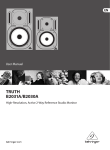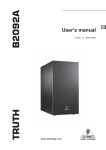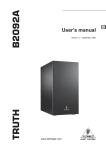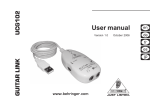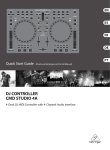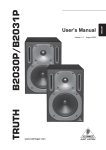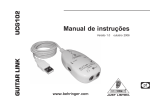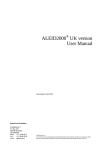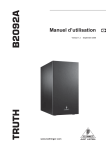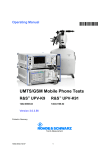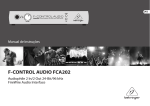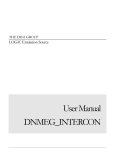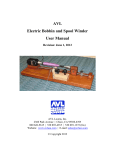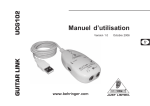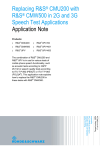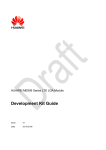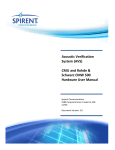Download 1GA51_0e - Rohde & Schwarz
Transcript
Generating the Noise Field for Ambient Noise Rejection Tests Application Note Products: | R&S UPV | R&S UPV-K9 | R&S UPV-K91 Thomas Lechner Feb.09 2010 - 1GA51_0e Application Note This document describes how to generate the noise field for ambient noise rejection tests according to 3GPP TS 26.132, sections 7.9 and 8.9. Table of Contents Table of Contents Rohde & Schwarz 1 Background ............................................................................ 4 1.1 3GPP Mobile Phone Tests R&S UPV-K9, UPV-K91 .................................4 1.2 Ambient Noise Rejection (ANR) Tests .......................................................4 1.3 Requirements on the noise field.................................................................4 2 General Description ............................................................... 6 2.1 Required Equipment ....................................................................................6 2.1.1 Equipment List..............................................................................................6 2.1.2 Audio CD with Pink Noise Signal................................................................6 2.1.3 CD Player.......................................................................................................6 2.1.4 Equalizer........................................................................................................6 2.1.5 Loudspeakers ...............................................................................................6 2.1.6 Amplifier (required with passive loudspeakers) .......................................7 2.2 Test Setup .....................................................................................................7 2.2.1 Test Room .....................................................................................................7 2.2.2 Loudspeaker Arrangement..........................................................................7 2.2.3 Connections..................................................................................................8 2.3 Adjustment....................................................................................................8 2.3.1 Order of Adjustment ....................................................................................8 2.3.2 Spectrum Adjustment ..................................................................................8 2.3.3 Level Adjustment .........................................................................................8 2.3.4 Overall ...........................................................................................................9 3 Implementation with Specific Equipment .......................... 10 3.1 Equipment List............................................................................................10 3.2 Connections................................................................................................10 3.3 Adjustment..................................................................................................11 3.3.1 Settings of the Active Speakers................................................................11 3.3.2 Basic Settings of the Equalizer.................................................................11 3.3.2.1 I / O Menu ....................................................................................................11 3.3.2.2 Utility Menu .................................................................................................11 3.3.2.3 Bypass Menu ..............................................................................................12 3.3.3 Spectrum Adjustment ................................................................................12 3.3.4 Level Adjustment for one speaker............................................................13 ® Generating the Noise Field for Ambient Noise Rejection Tests 1GA51_0e 2 Table of Contents Rohde & Schwarz 3.3.5 Checking the performance of the total setup..........................................14 3.3.6 Performing the Test ...................................................................................14 4 Literature............................................................................... 15 5 Abbreviations ....................................................................... 15 6 Ordering Information ........................................................... 15 Generating the Noise Field for Ambient Noise Rejection Tests 1GA51_0e 3 Background 1 Background 1.1 3GPP Mobile Phone Tests R&S® UPV-K9, UPV-K91 ® As a supplement to Audio Analyzer R&S UPV, Rohde & Schwarz provides options ® ® R&S UPV-K9 (Base SW for Mobile Phone Tests) and R&S UPV-K91 (UMTS/GSM Mobile Phone Tests) which can be used together with Universal Radio Communication ® Tester R&S CMU200 for acoustic tests on mobile phones according to 3GPP TS 26.132. One of the test cases specified in 3GPP TS 26.132 is Ambient Noise Rejection, which requires equipment for generating a diffuse sound field in the test room. This equipment is not comprised with the options. Therefore this application note explains how to generate and adjust the required diffuse noise field with commonly available equipment. ® For details on the operation of the UPV-K9x software provided with option R&S ® ® UPV-K91, see “R&S UPV-K9, R&S UPV-K91 Operating Manual”. 1.2 Ambient Noise Rejection (ANR) Tests Ambient noise rejection is a property of a telephone in sending direction. Ambient noise rejection tests deliver a spectrally weighted ratio between the sending sensitivity of a telephone for speech signals (speech send sensitivity) and its sending sensitivity for background noise (room noise sensitivity). The ambient noise rejection test as specified in 3GPP TS 26.132 assumes that the properties of the telephone are sufficiently time-invariant to allow separate measurement of room noise sensitivity and speech send sensitivity. Furthermore it is assumed that the rejection of the relatively uniform pink noise is somehow correlated with the rejection of other types of noise like street noise and background voices. 1.3 Requirements on the noise field According to 3GPP TS 26.132, the noise should be band limited between 100 Hz and rd 8 kHz. The spectrum should be “pink” which means that the 3 octave levels within this rd frequency band should be independent of the center frequency of the 3 octave bands. The tolerance of this spectral uniformity is defined to be ±3 dB. The total level of the noise should be 70 dBSPL(A), equal to -24 dBPa(A) at the mouth reference point with a tolerance of ±1 dB. The level and spectrum at the mouth reference point is to be adjusted in absence of the test head or HATS, respectively. Rohde & Schwarz Generating the Noise Field for Ambient Noise Rejection Tests 1GA51_0e 4 Background The noise field has to be diffuse. As a proof for the diffusity of the noise field it has to rd be assured that the 3 octave levels between 100 Hz and 3.15 kHz (narrow band) or between 100 Hz and 6.3 kHz (wide band) respectively, are uniform within ±3 dB within a radius of 0.15 m around the mouth reference point (MRP). It should be noted that this requirement can theoretically be fulfilled with a single speaker in sufficient distance from the MRP in free field, whereas a real diffuse sound field also exhibits random direction of the sound incidence. When measuring telephones with directional microphones, different results of the ANR measurement have to be expected with different direction of the noise sound incidence. Therefore it is recommended to use at least four loudspeakers with uniform spatial distribution for the generation of the sound field. In measurement rooms with non-anechoic conditions a higher number of speakers may be needed to achieve the required uniformity. To avoid interference between signals from different loudspeakers, each speaker has to be fed with an own noise signal which is not correlated with the noise signal of any of the other loudspeakers. Rohde & Schwarz Generating the Noise Field for Ambient Noise Rejection Tests 1GA51_0e 5 General Description 2 General Description 2.1 Required Equipment 2.1.1 Equipment List F F F F F F F ® Audio Analyzer R&S UPV with options UPV-K9 and UPV-K91 Audio CD(s) with pink noise signal CD Player(s) Equalizers Loudspeakers Power amplifier(s) for passive speakers Connection cables 2.1.2 Audio CD with Pink Noise Signal The audio CD should contain at least one sufficiently long track with two uncorrelated pink noise signals on the two channels. An image of such a CD is provided on the download site of this application note. 2.1.3 CD Player In principle one CD player is required for each pair of loudspeakers. If equalizers are used which offer a delay function of at least 250 ms, the delay can be used to decorrelate the noise signals. In this case each CD player can serve four loudspeakers. An audio CD image with two tracks of two-channel uncorrelated band-limited pink noise is available for download on the download site of this application note. 2.1.4 Equalizer rd Ideally the equalizer should be a graphic equalizer with 3 octave resolution. Furthermore a sum gain control is required, either in the equalizer or in the power amplifier(s). A delay function in the equalizer can be utilized to generate additional uncorrelated noise channels from the same source (CD player), see above. 2.1.5 Loudspeakers The loudspeaker frequency response should be sufficiently flat between 100 Hz and 8 kHz to allow equalization with the utilized equalizers. In addition to the deviation of the loudspeaker frequency response measured in free field there may be effects of a non-ideal room, particularly in the low frequency region. A suspension facility is needed for the speakers to allow their positioning in the required spatial arrangement. Rohde & Schwarz Generating the Noise Field for Ambient Noise Rejection Tests 1GA51_0e 6 General Description 2.1.6 Amplifier (required with passive loudspeakers) Active speakers eliminate the need for an additional power amplifier. If a power amplifier is needed, the maximum continuous output power should not be higher than the power rating of the loudspeakers. 2.2 Test Setup 2.2.1 Test Room As the speech send sensitivity of the telephone has to be measured in free field, the test room needs to be sufficiently anechoic in the measurement frequency range. To accommodate the speaker arrangement as suggested below, the test room should have a minimum free space of about 1.5 x 1.5 x 1.5 m. Furthermore suspensions or supports have to be provided in the room at the required loudspeaker positions. 2.2.2 Loudspeaker Arrangement For a good spatial distribution a minimum of four speakers is required. The optimum arrangement for four speakers is a regular tetrahedron, i.e. two speakers are positioned near the room floor in two diagonally opposite corners of a virtual cube. The other two speakers are positioned in two upper corners of this cube which are not above the first two speakers. Eight speakers should be positioned in the eight corners of a virtual cube. If possible, the speakers should be inclined towards the MRP. To assure the spatial uniformity of the noise field, a minimum distance of 1m between each of the speakers and the MRP is recommended. Rohde & Schwarz Generating the Noise Field for Ambient Noise Rejection Tests 1GA51_0e 7 General Description Deviations from the ideal arrangement are possible as long as the tolerance for the spatial uniformity of the noise field is not exceeded. If the test room is not ideally anechoic down to 100 Hz, the low-frequency response of each speaker may depend on its distance from the walls. Fine tuning of the speaker positions may be required if the low-frequency response cannot be equalized easily. 2.2.3 Connections Connect the equalizer inputs to the appropriate CD player outputs. Depending on the equipment this may be analog or digital S/P-DIF electric or optical (TOSLINK). If the equalizer(s) also offer a sum gain control, active speakers may be connected directly to the equalizer outputs. For passive speakers, power amplifiers are connected to the equalizer output, and the loudspeakers are connected to the outputs of the power amplifiers. 2.3 Adjustment 2.3.1 Order of Adjustment Mark the position of the MRP of the artificial mouth in use and remove the HATS or LRGP test head, respectively, from the measurement room. For the measurement at the MRP, the measurement microphone may be positioned at the MRP before removing the test head. For the measurements in 0.15 m distance, another utility like the tip of a microphone boom, is required to mark the MRP. It is suggested to start with adjusting the speakers one after the other, first in spectrum and then in level. As the noise signals are not correlated, the signals of the speakers will add up in power at the MRP. Finally the spectrum, level and spatial distribution of the total noise field is verified. 2.3.2 Spectrum Adjustment Using the “Adjust Spectrum” function of the ambient noise field calibration (“Calibration ® ® Ambient noise field”) of the R&S UPV-K9x software provided with option R&S rd UPV-K91, the 3 -octave spectrum of the pink noise is adjusted as far as possible to a rd flat line by trimming the respective 3 -octave gains in the respective equalizer channel. 2.3.3 Level Adjustment The level of each speaker has to be adjusted to -24 dBPa(A) - 10 * log10 n, with n being the number of speakers. With four speakers, each speaker has to be adjusted to -30 dBPa(A), with eight speakers each speaker has to be adjusted to -36 dBPa(A).The ® level adjustment function of the ambient noise field calibration of the R&S UPV-K9x software can be used for this purpose. Rohde & Schwarz Generating the Noise Field for Ambient Noise Rejection Tests 1GA51_0e 8 General Description It is suggested to take the number of speakers into account by first adjusting each speaker to -24 dBPa(A) at MRP and reducing the gain in the amplifier or equalizer by the appropriate level difference before activating all speakers. 2.3.4 Overall After all speakers have been adjusted, the total spectrum and level are checked, first at the MRP, then at 0.15 m distance around the MRP in at least 6 orthogonal spatial directions. This can be either done with the separate spectrum adjustment and level adjustment functions of the ambient noise field calibration, or with its “Measurement” function. Note that the last “Measurement” is stored as calibration value and has therefore to be carried out at the MRP. Rohde & Schwarz Generating the Noise Field for Ambient Noise Rejection Tests 1GA51_0e 9 Implementation with Specific Equipment 3 Implementation with Specific Equipment 3.1 Equipment List The following table lists the required equipment for n loudspeakers. Equipment for Pink Noise Generator Quantity Description Type Manufacturer ® 1 Audio Analyzer R&S UPV Rohde & Schwarz 1 Base SW for Mobile Phone Tests R&S®UPV-K9 Rohde & Schwarz ® 1 UMTS/GSM Mobile Phone Tests R&S UPV-K91 Rohde & Schwarz n/4 Audio CDs Download image Rohde & Schwarz n/4 CD Player Not specified Not Specified n/2 Equalizer Ultracurve DEQ2496 Behringer n Active Loudspeaker Truth B2031 Behringer n Speaker cables XLR male – XLR female Not specified n/4 Connection cable RCA - BNC Not specified n/2 BNC T-connector Not specified Not specified n Short BNC cables Not specified Not specified n ® Adapters BNC – XLR male R&S UPL-Z1 (2 per set) Rohde & Schwarz The standard cables and adapters may be replaced by custom made cables. 3.2 Connections OUT R OUT L OUT R OUT L AES/EBU IN AES/EBU IN Rohde & Schwarz Generating the Noise Field for Ambient Noise Rejection Tests 1GA51_0e 10 Implementation with Specific Equipment 3.3 Adjustment 3.3.1 Settings of the Active Speakers F F F F Set “Power Mode” to “On” Set “Mute High” and “Mute Low” to “Off” Set the “Input Trim” control to minimum (-6 dB) Set “Low Frequency”, “Room Compensation” and “High Frequency” to “0 dB”. These controls may be used later on if equalization exceeding the range of the equalizer controls is required. 3.3.2 Basic Settings of the Equalizer 3.3.2.1 I / O Menu The input has to be set on the first page according to the connection used, i.e. “MAIN IN” for analog connection from the CD player, “DIG. In XLR” for S/P-DIF connection and “DIG. IN OPT.” for Toslink connection. If four speakers are fed from one CD via two equalizers, in one of the equalizers (only!) the delay has to be enabled for the main output and to be set to maximum. This is done on page 4 of the I / O menu: Set the unit to “MSEC” and the value for both channels to “300”. 3.3.2.2 Rohde & Schwarz Utility Menu Generating the Noise Field for Ambient Noise Rejection Tests 1GA51_0e 11 Implementation with Specific Equipment F F 3.3.2.3 Set “CHANNEL MODE” to “DUAL MONO”. This allows to set the equalizer for both channels independently. For alignment of one out of four speakers, set “GAIN OFFSET (EQ)” to -9 dB. For alignment of one out of eight speakers, set it to -3 dB. Before all speakers are turned on, set it to -15 dB. This compensates for the level increase caused by the number of speakers. Bypass Menu In both channels, all modules except the graphic equalizer (“GEQ”) must be bypassed. 3.3.3 Spectrum Adjustment Place a calibrated diffuse field microphone at the MRP before starting the adjustment. Connect the microphone via a suitable power supply (e.g. conditioning Amplifier) to ® R&S UPV analyzer input 1. The HATS or test head must be removed before the adjustment. Make sure to memorize the position of the MRP. The HATS or test head must be put back later on with the MRP at the same position in the room. Steps 3.3.3 and 3.3.4 have to be performed for each speaker separately. Switch all speakers off. Switch on only the speaker to be adjusted next. Make sure which channel of which equalizer is assigned to the speaker currently activated. 2 1 Use button “B” to select the correct channel. Use wheel 2 to select the frequency band. Use wheel 1 to adjust the gain in 0.5 dB steps. ® Start “Calibration Ambient noise field” in the R&S UPV-K9x program. Start “Adjust Spectrum”. Start the playback of the pink noise in the CD player. ® The level scale of the spectrum display of the R&S UPV-K9x program auto-scales such that the spectrum curve is centered within the red limit lines. With a total level of rd -24 dB(A) the average 3 octave level is expected around -35 dBPa (unweighted). Rohde & Schwarz Generating the Noise Field for Ambient Noise Rejection Tests 1GA51_0e 12 Implementation with Specific Equipment Set the gain at 80 Hz and 10 kHz to minimum. Adjust the spectrum to a horizontal line by increasing the gain for frequency bands where the level is below the average and reducing the gain for frequency bands where the level is above average. Once the spectrum is sufficiently flat, click or press softkey “Stop Adjustment” in the user interface of the K9x software. 3.3.4 Level Adjustment for one speaker Start the “Adjust Level” function”. Press wheel 2 on the equalizer to activate the sum gain on the right end of the display. Adjust the level to -24 dBPa(A) using wheel 1. Rohde & Schwarz Generating the Noise Field for Ambient Noise Rejection Tests 1GA51_0e 13 Implementation with Specific Equipment 3.3.5 Checking the performance of the total setup As soon as all speakers have been adjusted separately, set “Gain offset (EQ)” in the utility menu to -15 and switch on all speakers. You can now use the “Adjust spectrum” and “Adjust Level” functions to check the total adjustment. If everything is within tolerance, check spectrum and level for a number of points in at least 0.15 m radius around the MRP. At last, place the measurement microphone at MRP again and click or press softkey “Start Measurement”. Spectrum and level at MRP are now measured and the tolerances is checked. If the result is within tolerance, it is stored as calibration value for the ambient noise rejection measurement. A report can be generated and exported before closing the window with the result of this measurement. 3.3.6 Performing the Test After step 3.3.5 has been completed successfully, re-install the HATS or LRGP test head, respectively, in the test room with the MRP at its original position. Establish a call to the mobile and start the test case. The noise field must be present when the test is started. During the test execution, the operator is prompted to switch off the noise field. This can be done by stopping the playback of the CD(s). Rohde & Schwarz Generating the Noise Field for Ambient Noise Rejection Tests 1GA51_0e 14 Literature 4 Literature F F F F 3GPP TS 26.132 “Speech and video telephony terminal acoustic test specification” http://www.3gpp.org/ftp/Specs/html-info/26132.htm ® ® R&S UPV-K9, R&S UPV-K91 Operating Manual http://www2.rohde-schwarz.com/en/products/test_and_measurement/audio/UPV-|Manuals-|-22-|-2224-|-2224.html Ultracurve Pro DEQ2496 User’s Manual http://www.behringer.com Truth B2030A/B2031A User’s Manual http://www.behringer.com 5 Abbreviations rd 3GPP ANR HATS LRGP MRP 3 Generation Partnership Project Ambient Noise Rejection Head-and-Torso Simulator Loudness Rating Guardring Position Mouth Reference Point 6 Ordering Information Ordering Information Type of instrument Description Instrument type Ordering number Audio Analyzer R&S®UPV or 1146.2003.02 ® 1146.2003.66 ® R&S UPV66 Rohde & Schwarz XLR/BNC Adapter Set R&S UPL-Z1 1078.3704.02 Base SW for Mobile Phone Tests R&S®UPV-K9 1402.0008.02 ® UMTS/GSM Mobile Phone Tests R&S UPV-K91 1402.0108.02 Universal Radio Communication Tester R&S®CMU200 1100.0008.02 ® Option versatile signalling unit R&S CMU-B21V14 1100.5200.02 Speech codec for sig. unit R&S®CMU-B52V14 1100.5400.02 ® WB-AMR Codec R&S CMU-K46 SW option according to GSM band R&S®CMU_K2x WCDMA (3GPP FDD) signalling module R&S®CMU-B56 v54 ® 1200.8800.02 1150.1850.54 Versatile baseband board for WCDMA R&S CMU-B68 1149.9809.02 UE test signalling software R&S®CMU-PK60 1159.3355.04 Generating the Noise Field for Ambient Noise Rejection Tests 1GA51_0e 15 About Rohde & Schwarz Rohde & Schwarz is an independent group of companies specializing in electronics. It is a leading supplier of solutions in the fields of test and measurement, broadcasting, radiomonitoring and radiolocation, as well as secure communications. Established 75 years ago, Rohde & Schwarz has a global presence and a dedicated service network in over 70 countries. Company headquarters are in Munich, Germany. Environmental commitment F Energy-efficient products F Continuous improvement in environmental sustainability F ISO 14001-certified environmental management system Regional contact USA & Canada USA: 1-888-TEST-RSA (1-888-837-8772) from outside USA: +1 410 910 7800 [email protected] East Asia +65 65 13 04 88 [email protected] Rest of the World +49 89 4129 137 74 [email protected] This application note and the supplied programs may only be used subject to the conditions of use set forth in the download area of the Rohde & Schwarz website. R&S® is a registered trademark of Rohde & Schwarz GmbH & Co. KG. Trade names are trademarks of the owners. Rohde & Schwarz GmbH & Co. KG Mühldorfstraße 15 | D - 81671 München Phone + 49 89 4129 - 0 | Fax + 49 89 4129 – 13777 www.rohde-schwarz.com
















